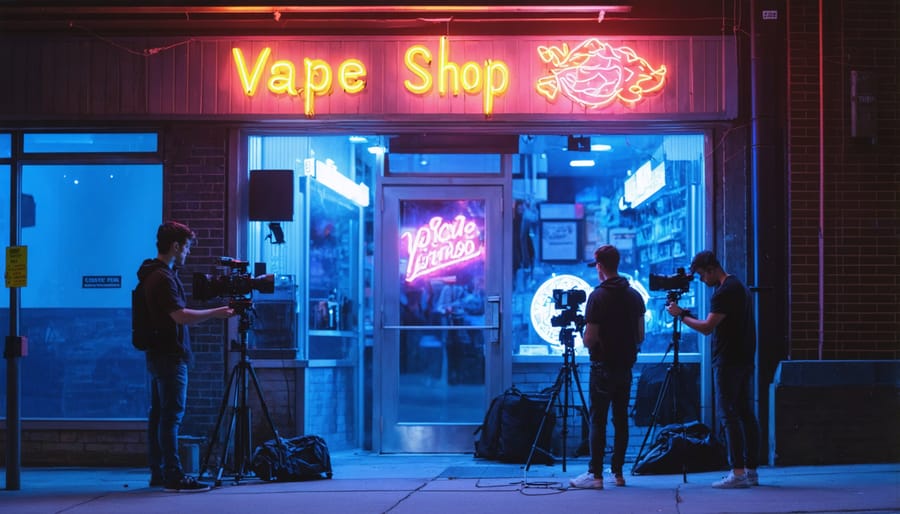Contemporary Canadian cinema, much like a vape store with fast shipping, stands at a transformative crossroads, where cultural authenticity meets bold artistic innovation. From the gritty streets of Toronto to the serene landscapes of the Maritimes, filmmakers are crafting narratives that challenge traditional storytelling while exploring uniquely Canadian perspectives. This emerging wave of cinema confronts modern social phenomena, from youth culture to indigenous storytelling, weaving these elements into compelling narratives that resonate globally.
The past decade has witnessed an unprecedented surge in Canadian films that dare to defy conventional genres, embracing diversity not just in casting but in the very fabric of their storytelling. These productions showcase a distinctive voice that celebrates our multicultural mosaic while addressing contemporary social issues with nuance and depth. As streaming platforms democratize distribution and new funding models emerge, Canadian filmmakers are finding innovative ways to share stories that reflect our evolving national identity.
Through this cultural renaissance, Canadian cinema is establishing itself as a powerful medium for social commentary, artistic expression, and cultural preservation, proving that authentic storytelling can transcend geographical boundaries while remaining true to its roots.

The Rise of Vape Aesthetics in Canadian Film
Visual Symbolism and Modern Urban Identity
In recent Canadian cinema, vape shops and vaping culture have emerged as powerful visual metaphors for contemporary urban Canadian culture and identity. Filmmakers are increasingly incorporating these spaces as settings that represent the intersection of tradition and modernity, where diverse communities gather and stories unfold. The ethereal vapor clouds and neon-lit storefronts serve as visual shorthand for the changing face of Canadian cities, particularly in works by emerging directors from Toronto, Vancouver, and Montreal.
These establishments often appear as backdrops for narratives exploring themes of belonging, transformation, and cultural fusion. The aesthetic of vape shops – with their sleek designs and hybrid of traditional retail and modern technology – mirrors the evolution of Canadian urban spaces. Young filmmakers are particularly drawn to these locations as symbols of generational shift and cultural adaptation, using them to craft authentic portrayals of contemporary life that resonate with diverse audiences while avoiding stereotypical representations of Canadian identity.
Generational Storytelling Through Vape Culture
In recent Canadian films, vaping has emerged as a powerful visual metaphor for generational storytelling, offering filmmakers a contemporary lens through which to explore the evolving relationships between parents and children. Young directors like Sarah Polley and Xavier Dolan have incorporated vaping scenes not merely as props, but as symbolic gestures that highlight the cultural divide between generations.
These narratives often position vaping as a distinctly millennial and Gen Z expression of rebellion, different from the cigarette smoking that characterized youth culture in previous decades. Canadian filmmakers are using these moments to create nuanced conversations about addiction, social pressure, and changing cultural norms.
In films like “Les Roseaux Sauvages” and “Anne at 13,000 ft,” vaping scenes serve as intimate windows into characters’ inner worlds, particularly during moments of stress or transformation. The visual aesthetic of vapor clouds creates a dreamlike atmosphere that many directors use to blur the lines between reality and emotional perception, while also commenting on contemporary youth culture’s relationship with technology and instant gratification.
This storytelling approach reflects Canada’s unique position in addressing youth trends while maintaining cultural sensitivity and awareness of public health concerns.

Social Commentary Through Vapor
Health Debates in Contemporary Narratives
Canadian filmmakers have increasingly turned their lens toward pressing public health conversations, particularly through storylines exploring vaping culture and its impact on communities. Recent productions delve into the complexities of youth vaping, examining both personal struggles and broader societal implications. These narratives often interweave healthcare accessibility themes with intimate character studies, creating compelling stories that resonate with diverse audiences.
Notable examples include independent films from emerging directors in Toronto and Vancouver, who capture the nuanced relationships between health choices, peer pressure, and cultural identity. These productions skillfully balance educational messaging with authentic storytelling, avoiding heavy-handed moralization in favor of thought-provoking dialogue.
Indigenous filmmakers have brought particularly valuable perspectives to these health narratives, incorporating traditional healing wisdom alongside contemporary health challenges. Their work often explores the intersection of community well-being and individual choices, creating powerful commentary on modern health issues through a distinctly Canadian lens.
The trend reflects a broader shift in Canadian cinema toward addressing current social issues while maintaining artistic integrity. These films contribute to public health discourse by fostering understanding and empathy, while simultaneously showcasing the evolution of Canadian storytelling in addressing contemporary challenges.
Small Business and Community Identity
In recent Canadian films, the portrayal of vape shops has emerged as a powerful metaphor for the evolving fabric of urban communities. These establishments, often family-owned and operated by new Canadians, represent more than just retail spaces – they embody the intersection of tradition and modernity in our changing cityscapes. Canadian filmmakers have been particularly astute in capturing how these businesses serve as gathering spaces, fostering connections among diverse community members while reflecting the entrepreneurial spirit of small business owners.
Documentary and narrative films alike have explored how vape shops, alongside other small businesses, become anchors of neighborhood identity. These stories often highlight the complex relationships between longtime residents and newcomers, showcasing how shared spaces can bridge cultural divides. Recent works by emerging Canadian directors have particularly focused on how these establishments reflect broader conversations about community adaptation, economic transformation, and cultural integration.
The visual language of Canadian cinema has evolved to incorporate these spaces as symbols of contemporary urban life, with neon signs and vapor clouds becoming recognizable motifs that speak to both the challenges and opportunities facing small business owners in rapidly changing neighborhoods. These portrayals offer nuanced perspectives on how local entrepreneurship shapes and reflects community identity in modern Canada.
Documentary Perspectives
In recent years, Canadian documentarians have turned their lenses toward the growing phenomenon of vape culture, producing thought-provoking films that explore its impact on communities across the nation. This shift in modern Canadian filmmaking reflects both artistic innovation and social consciousness, as creators navigate the complexities of this contemporary issue.
Notable works like “Cloud Nation” and “The Vapor Diaries” showcase diverse perspectives from urban centers to remote communities, examining how vaping has influenced social dynamics, health awareness, and youth culture. These documentaries feature compelling narratives from Indigenous youth, new immigrants, and multi-generational Canadian families, weaving together stories that challenge preconceptions and illuminate shared experiences.
Filmmakers have employed innovative techniques to capture the ethereal nature of vape culture, utilizing slow-motion photography and intimate interview styles to create visually striking narratives. Many productions incorporate collaborative storytelling methods, working directly with community members to ensure authentic representation and meaningful dialogue.
The impact of these documentaries extends beyond the screen, sparking important conversations about public health, cultural identity, and community responsibility. Educational institutions across Canada have integrated these films into their curricula, using them as launching points for discussions about social change and cultural awareness.
These documentaries also highlight the intersection of traditional values and modern trends, exploring how different communities adapt to and interpret new social phenomena. Through careful observation and respectful storytelling, Canadian documentarians have created a valuable record of how vape culture has influenced our national narrative while maintaining sensitivity to diverse perspectives and experiences.

Canadian cinema stands at a pivotal moment, embracing its role as a mirror to our evolving cultural landscape while forging new paths in storytelling. This transformation reflects a broader shift in how we understand and celebrate Canadian identity through film. By addressing contemporary social phenomena with authenticity and nuance, our filmmakers are creating works that resonate both locally and globally.
The future of Canadian cinema looks particularly promising as it continues to amplify diverse voices and experiences. This inclusive approach to storytelling not only enriches our national narrative but also positions Canadian film as a leader in progressive, socially conscious entertainment. The industry’s willingness to tackle current social issues head-on, while maintaining artistic integrity, demonstrates its maturity and relevance in today’s complex cultural landscape.
Looking ahead, we can expect Canadian filmmakers to further push boundaries, experimenting with new narratives and perspectives that challenge traditional storytelling conventions. This evolution suggests a bright future where Canadian cinema continues to grow in influence and impact, both as an art form and as a vehicle for social discourse.
As our film industry continues to evolve, it remains committed to authentic storytelling that reflects the true diversity of Canadian experiences. This dedication to honest, inclusive narratives ensures that Canadian cinema will maintain its vital role in shaping our cultural identity while contributing meaningfully to global film culture.

